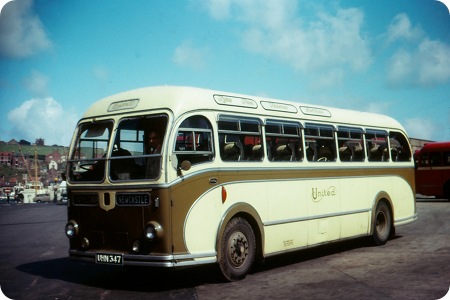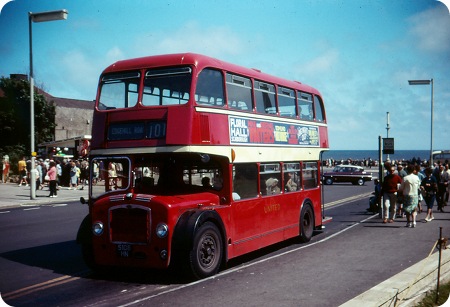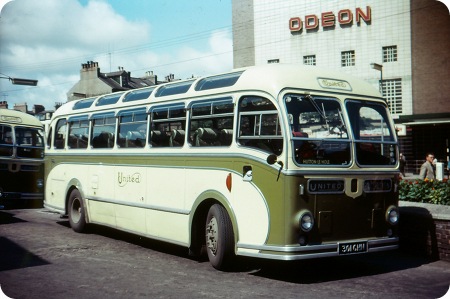
United Automobile Services
1958
Bristol LS6B
ECW C34F
Photo taking out side Scarborough railway station this is where United started there coach tours from I always liked the mystery tours. There was 1409 Bristol LS (light Saloon) built between 1953 – 58. United must of liked them, as they were by far the biggest buyer having 328 of them.
A full list of Bristol codes can be seen here.
A full list of United codes can be seen here.
I think the coach is from the UC1-5 series and they were stored at Darlington over the winter period, they were not used on the Tyne Tees service early in there lives. One I think gravitated to Morris Bros of Swansea.
Paul Fraser
There was a shot of this same vehicle in an issue of ‘Vintage Roadscene’ about two years ago. It was depicted outside Scarborough railway station, next to a board proclaiming ‘United afternoon coach tours leave here at 2.30 pm’. Standing in front of the coach is seen one Charlie Bullock, a long serving driver with United at Scarborough, and one of the town’s real characters. (For many years Charlie was the proud owner of ex-United 1940 Bristol K5G towing lorry FHN 923, which is now in the care of the preservation folk at Newton Aycliffe).
Brendan Smith
———
Another superb shot of a United coach in the Olive and Cream livery. One of these vehicles UC4 304GHN is currently under restoration with the Aycliffe & District Bus Preservation Society. I do believe that these 5 vehicles were used on holiday tours to Scotland and Devon when they were new.
Paul
01/01/12 – 07:11
Just a brief note to say that Charlie Bullock is still with us as of 31st December 2011 – !! I’m sure all bus preservationists will join me in wishing him a very Happy New Year.
Guy Stanbury
22/01/13 – 11:15
Sadly, Charlie Bullock died on 17th August 2012 aged 97. A link to an article in the Scarborough Evening News is here www.thescarboroughnews.co.uk/
John Darwent
22/01/13 – 12:29
Is it coincidence or providence that Charlie’s ride to eternity had gained a mournful looking grille by the time the Final Ride was taken…..?
David Oldfield
23/01/13 – 07:00
My partner and I were privileged to have attended Charlie’s funeral in Scarborough, and although it was sad to lose an old friend, the proceedings were far from being a sad affair. There was warmth and humour throughout the service, and the crematorium was absolutely packed – no mean feat for someone of 97. Charlie went in to the tune of ‘Sentimental Journey’, and we made our way out afterwards to ‘When the Saints Go Marching In’, just as he had planned. His coffin (which he’d had in storage for many years, ready as Charlie put it, for when he was "called up to Head Office!") – was draped with a United destination blind and floral tribute. Charlie even managed to put in a ‘personal appearance’ partway through the proceedings. With the help of a pre-recorded CD, he thanked everyone for coming to his ‘event’, and told us that he was the advance party and that he would no doubt see us all again at some stage! His ‘Old Beauty’ FHN923 performed her duty as Charlie’s personal transport admirably, in the hallowed company of United Bristol L5G LHN860, Doncaster AEC Regal III MDT222, and East Yorkshire open-top AEC Routemaster ALM65B. I have never been to a funeral before where so many people came out with a smile on their face. A fitting tribute to Charlie, a busman through and through, with a lovely sense of fun right up to the end.
Brendan Smith
23/01/13 – 11:23
Brendan, how I wish that I’d had the honour to meet Charlie, who was obviously a wonderful and enchantingly "mischievous" character as well as being a dedicated busman.
Just a slight deviation from this Bristol topic, but I too have the greatest admiration for the superb cream and olive green livery of the United coaches – dignity with boldness, not easy to achieve and sadly almost totally extinct today. My happiest memory of the livery is from my West Yorkshire conducting days on service 76 (Skipton – Tadcaster). Connections at important points were always specified on WYRCC running boards and my favourite was when we were due to leave Harrogate for Skipton at 4.00pm :-
"Connection must be made with United car for Liverpool due at 3.57 pm."
The United "CAR" was always one of the nine magnificent Leyland Royal Tigers, in olive green and cream of course, and it was never late as far as I recall !!
Chris Youhill
24/01/13 – 07:13
You have a way with words Chris, and "enchantingly mischievous" is very apt. Your comment about the ‘Harrogate Connection’ is fascinating – that really was customer service. Today, in this age of competitive competitiveness, such a sensible thing would be totally unacceptable. The Competition Commission would be down on West Yorkshire and United like a ton of cylinder heads. (Note: why is there only one Competition Commission? Alright for them eh?). Harrogate was a still a colourful place for buses and coaches when my family moved there in 1966, and United provided vehicles in red and cream, cream and red, and cream and olive green. They operated two Lodekka FSF6Bs on the Ripon – Harrogate 126 route, and various LS and MW buses and coaches could also be seen at points throughout the day. Also calling at Harrogate Bus Station (which we very nearly lost thanks to Meddlesome Maggie) were the coaches of Northern General and North Western, and the fascinating blue buses of Samuel Ledgard. A lovely time to be a thirteen year old bus spotter.
Brendan Smith
24/01/13 – 11:06
United and the NGT Group had a number of shared routes and return tickets were valid on either companies buses, in addition to that, in areas where several routes merged and they were joined by Newcastle Corporation vehicles, in the event of a breakdown the conductor/driver could issue a slip and transfer passengers to any vehicle. Silly me, I forgot to mention one very important point, at the time buses were classified as Public Service Vehicles and were regulated by the area Traffic Commissioners.
Ronnie Hoye
25/01/13 – 06:39
As you rightly say Brendan, Harrogate Bus Station was a wonderful place in those days, and there was a marvellous "class distinction" measure in force. West Yorkshire buses on the main 53 service to Bradford via Otley left from a stand near the railway station end, while we of Ledgard’s on our hourly departure set out from a stand half way down the bus station under a sign declaring "Bradford (S.Ledgard)"- obviously to remind us that we were extremely lucky to be allowed within West Yorkshire’s Temple of Excellence.
One other little gem concerning the 4.00pm service 76 to Skipton, on Fridays at least, was a duplicate to Burley in Wharfedale operated by a coach and driver hired from Wray’s of Summerbridge in the command of a West Yorkshire conductor.
Chris Youhill
26/01/13 – 06:32
Chris, your mention of Wray’s of Summerbridge (as it then was) reminded me that their coaches could often be seen on hire to West Yorkshire. Indeed they could frequently be seen resting contentedly next to WY’s Bristol/ECW machines on the forecourt of Harrogate’s Grove Park depot, especially in the summer months. Wray’s even had some Yeates-bodied coaches in their fleet (Riviera and Europa spring to mind), the flamboyant style of which contrasted markedly with the classic lines of WY’s LS and MW coaches of the period. Wray’s were taken over a few years ago by Eddie Brown of Helperby, and Wray’s attractive and distinctive livery was sadly phased out quite soon afterwards. Unfortunately, Eddie Brown’s livery is yet another variation of the bland ‘white coach’ scheme seen in many parts of the country, with odd bits of colour added to try and differentiate one operator’s vehicles from another. Eddie Brown’s coaches have swoops and swirls along the sides in maroon and orange, and it’s reasonably attractive, but to me it’s ‘just another white coach’, and lacks the ‘class’ of the Wray’s livery. Nearby Dodsworth’s Coaches of Boroughbridge show how it could be done, with their very distinctive and handsome livery of all over orange with a black roof. Simple, but stunning.
Brendan Smith
26/01/13 – 15:02
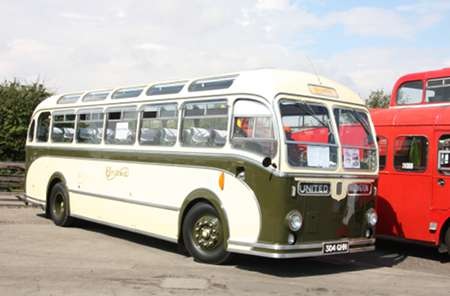
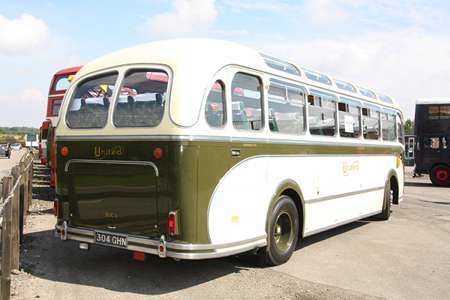
Copyright J.A.Charles
Thought that an up to date photo of one of this batch may be helpful. This was taken at a rally at Croft motor racing circuit last year.
Andrew Charles
27/01/13 – 07:53
Thank you for posting the photos Andrew. A fine looking coach indeed, further enhanced by that famous cream and olive green livery. The position of the rear number plate is interesting, and presumably this was specified by United. Usually on this type of coach it was located immediately below the rear windows, approximately where 304 GHN’s lovely scroll fleetname is. The polished front wheel nuts add the final touch – they are just as they would have been on delivery, and ‘very Bristol’.
Brendan Smith
